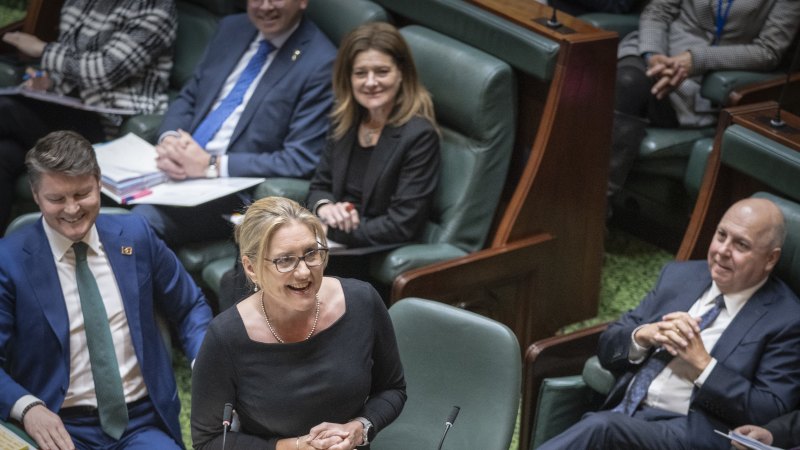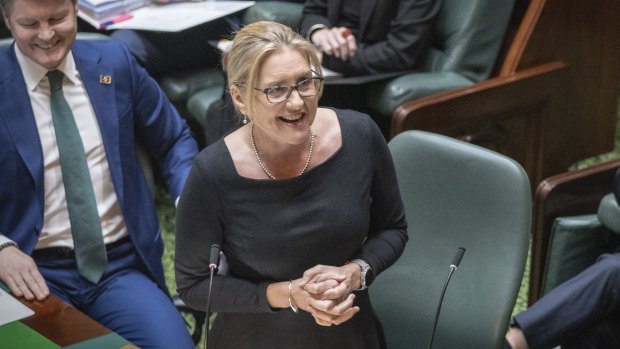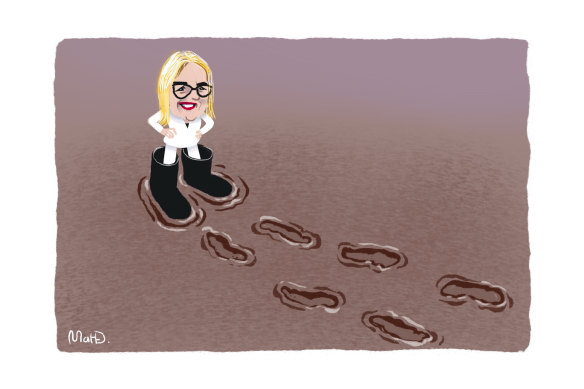Save articles for later
Add articles to your saved list and come back to them any time.
As the dust settles on the leadership transition from Daniel Andrews to Jacinta Allan, it is worth speculating on what kind of premier Allan will be over the next three years. What will be the features of her leadership, how will it be distinguished from Andrews’ approach and how might she fare as premier?
Perhaps inevitably, the influence of Allan’s gender has already been to the fore of such conjecture. The first question Allan faced in the media conference that followed her crowning as Labor leader was how she felt about being Victoria’s second female premier after Joan Kirner.
Premier Jacinta Allan in parliament this week.Credit: Eamon Gallagher
One immediate point on her gender is that, unlike when Kirner was premier between 1990 and 1992, female leaders are no longer such a novelty at the sub-national level of government in Australia. With Allan’s ascension there have now been 13 women leaders of the states and territories with 10 in power this century. In other words, although progress is still too slow, female leaders are gradually being normalised at this level of government.
Nevertheless, women leaders are still rare enough to attract curiosity and provoke questions about how they differ from the blokes. Stereotypically, it is assumed women will be more collaborative and empathetic than their male counterparts. Yet, in practice, female leaders are as diverse in ruling style as men are. But what is particular to female leaders is that they can be caught in what is dubbed in the political science literature a “double bind”. That is, they either mimic masculinist leadership modes (decisiveness and aggression), which transgresses gender norms and erodes their likeability, or they take a “feminalist” approach (for example, being more conciliatory), which risks accusations that they are too weak for leadership. Will Allan be ensnared by this bind?
Another dilemma that can plague female leaders, and which might present for Allan, concerns how much emphasis they place on their gender. To not do so can disappoint fellow women, but to do so can draw allegations of playing the gender card, as Julia Gillard suffered.
Allan is expected to be a more collegial leader than her predecessor for reasons beyond her gender. One is that Andrews’ domineering style had worn thin by the time he relinquished office. The public are likely to welcome a less crash-through mode of leadership. Here, there is a parallel with Steve Bracks’ replacement of Jeff Kennett as premier in 1999. Kennett’s steamroller rule had grown oppressive to Victorians who yearned for something gentler. The congenial Bracks fitted the bill perfectly with his emollient approach.
Credit: Matt Davidson
Another reason why Allan is likely to be a more consensus-driven leader than Andrews is that her Labor colleagues will insist on it. Coerced by Andrews for more than a decade, there is pent-up desire by ministers and backbenchers to have a greater say in the way their government runs. A test for Allan will be to answer the demand for distributed decision-making while maintaining a cohesive administration.
Allan’s initial media conference as Labor leader gave other clues as to what we can expect from her over the next three years. In two respects, there was striking continuity between her statements at that media conference and her inaugural speech to the parliament in 1999. First, was the emphasis on responsiveness to community. In that inaugural speech, she declared: “I believe strongly in the role and rights of the community in the decision-making process … we as legislators must ensure that they [the community] have the opportunity to participate.” Second, was her nomination of equality of opportunity as the keystone of her political philosophy, an ideal first made central to Labor’s mission by Gough Whitlam. “I believe”, Allan said in her inaugural speech, “that no matter where they live, no matter what family they were born into or no matter what school they went to, all people must be given the same opportunities in life.”
In policy terms, one thing that stood out in Allan’s first media conference as leader was her commitment to carrying through with Labor’s treaty-making with Victoria’s Indigenous communities. In the context of the Voice referendum’s probable defeat, and the consequent setting back of aspirations for a federal government-led treaty process, state-based progress in this arena will become all the more crucial.
Finally, what of Allan’s prospects of success as premier? Having enjoyed a charmed political career – experiencing only one term of opposition in a quarter of a century in parliament – will she be able to extend Labor’s hegemony?
A large question is whether she has the genius of political judgment and communication gifts of her predecessor. Her challenges are also significant, not least reining in Victoria’s debt while still delivering on the Big Build infrastructure projects. Then there is the fact that Allan heads an ageing government. When voters next go to the polls in 2026, there will be a powerful “It’s Time” factor working against Labor. On the other hand, strongly in Allan’s favour is a divided Liberal Party that struggles for relevance and which most voters do not regard as a viable alternative government.
Ironically, it is the Liberal side of politics that provides a historical precedent from which Allan can take greatest heart. In 1972, the genteel Rupert Hamer succeeded another long-serving strong-man premier, Henry Bolte, and proceeded to win another three elections for his party. The secret to Hamer’s durability was reinventing the image of the government by embracing a progressive social liberalism aimed at improving the quality of life of the state’s citizens. It is a formula for success in Victorian politics still applicable today.
Paul Strangio is emeritus professor of politics at Monash University.
The Opinion newsletter is a weekly wrap of views that will challenge, champion and inform your own. Sign up here.
Most Viewed in National
From our partners
Source: Read Full Article


